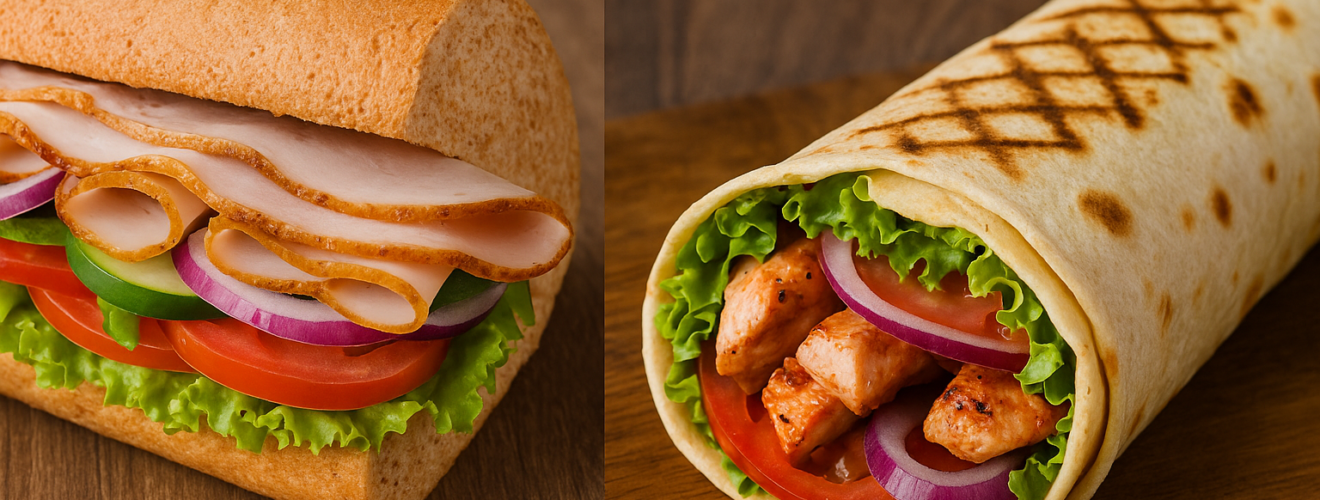Food Quality Tarnished: Are Big Names Any Better Than Street Food?

We trust glossy packaging.
We trust glowing signboards.
We trust air-conditioned spaces with spotless menus and trained staff.
But should we?
In recent months, food-safety officials across India have carried out inspections in several big-name restaurant chains — including global fast-food brands, café franchises, and even popular packaged snack makers. Their findings shook many people who always believed that “brand equals safety.”
Social media lit up with disbelief. How could international chains or established Indian names fail basic food-safety checks? Weren’t they supposed to be better than the small vendor frying samosas at the corner of the market?
This wave of news has reignited a question every Indian eater asks quietly but rarely says out loud:
When it comes to food quality, are big brands really any better than street food?
The Reality Behind the Kitchen Door
Every restaurant, whether a massive franchise or a small cart, deals with the same basic challenges — perishable ingredients, hygiene maintenance, temperature control, and human behavior.
In theory, a big chain has the advantage. They have structured processes, trained managers, and supply chains monitored by global systems. Yet, when the food-safety department conducts surprise tests, even these giants stumble.
Inspectors often find stale oil, low-quality ingredients, or samples with bacterial contamination. The shock isn’t that it happens — it’s that it happens so often.
The truth is simple: the bigger the operation, the harder it is to maintain quality everywhere. What works in a corporate presentation often falls apart in a busy outlet run by underpaid staff rushing to meet delivery targets.
What the Inspections Revealed
In early October 2025, food-safety teams in northern India collected samples from multiple well-known chains. The results highlighted how widespread small failures can become when systems stretch too thin.
Below is a simplified table reflecting the kinds of issues food-safety officials reportedly found in such audits across India. It combines findings from multiple public reports and patterns noted in similar inspections over the past year.
Table: Snapshot of Food-Safety Issues Found in Chain Outlets (Illustrative Summary)
| Type of Outlet | Example Product | Nature of Problem | Likely Cause | Consumer Risk |
|---|---|---|---|---|
| Global fried-chicken chain | Fried chicken piece | Excessive reused oil; high trans-fat content | Oil not replaced as per protocol | Digestive issues, heart health risk |
| Indian snack brand outlet | Packaged namkeen sample | High moisture content | Improper drying or storage | Spoilage, mold growth |
| Pizza restaurant chain | Cheese topping | Bacterial contamination | Poor refrigeration | Food poisoning risk |
| Coffeehouse chain | Cold beverage sample | Excess sugar, unapproved flavor additive | Supply error, inconsistent recipe | Metabolic concerns |
| Fast-food burger chain | Patty sample | Substandard meat texture | Use of frozen stock past ideal date | Taste deterioration, health hazard |
| Street food stall (comparative sample) | Pani puri water | E. coli presence | Unfiltered water | Gastrointestinal infection |
| Local tandoor eatery | Paneer tikka | Excess artificial coloring | Vendor-level adulteration | Allergic reaction risk |
| Bakery chain | Cream pastry | High bacterial count | Improper storage temperature | Foodborne illness risk |
| Packaged juice manufacturer | Bottled juice | Label mismatch (fruit content vs actual) | Misbranding, lack of QA | Consumer deception |
| Ice cream kiosk | Ice cream scoop | Excess ice crystals, freezer burn | Interrupted cold chain | Taste and texture issues |
Patterns Behind the Problems
When regulators test food, they don’t just look for contamination. They look for consistency, authenticity, and safety.
The surprise is that big brands often fail on consistency — something you’d expect them to control best.
Why? Because systems depend on people, and people get tired, cut corners, or follow shortcuts when under pressure.
Here are some of the biggest systemic reasons behind these lapses:
1. Franchise Dilution
Most large restaurant brands in India operate on a franchise model. The corporate entity sets the standards, but local franchise owners handle daily operations.
If a store owner skips oil change cycles, buys cheaper ingredients, or ignores cleaning schedules, the brand suffers — even if headquarters never knew about it.
This gap between policy and practice is the biggest reason for food-quality inconsistency in chain outlets.
2. Supply Chain Complexity
A small eatery sources vegetables from the local market. A big brand sources them from multiple vendors across states. Every step — from farm to warehouse to outlet — adds risk.
If refrigeration fails at one transport hub, hundreds of restaurants receive compromised stock. By the time the food reaches your plate, it still looks fine, but the invisible bacteria are already growing.
Big brands rely on scale, but scale brings fragility.
3. Staff Turnover and Training
A major fast-food outlet can have 30–40 employees. Many are contractual workers earning hourly wages. Turnover is high.
Every time someone leaves, a new person joins with minimal training. Cleaning protocols, temperature logs, and hygiene checks depend on consistency — and that disappears when employees keep changing.
Street food vendors, by contrast, usually work with family members. They know every corner of their setup. They cook small batches, serve fast, and finish early. Ironically, their limited scale keeps them more consistent.
4. The Pressure of Speed and Volume
Delivery apps promise 20-minute arrivals. Quick-service restaurants compete for “fastest delivery” badges. In that rush, corners get cut.
Oil isn’t replaced as often as it should be. Frozen items stay thawed longer. Gloves get reused. A missed sanitization cycle doesn’t seem like a big deal until something goes wrong.
Big brands run on time metrics. Street vendors run on customer satisfaction.
One chases algorithms; the other listens to direct feedback.
5. Regulation and Enforcement Gaps
India’s Food Safety and Standards Authority (FSSAI) sets clear rules, but enforcement depends on state-level officers.
A metro city might run frequent checks, but smaller towns often don’t. A large brand operates everywhere, so an issue unnoticed in one district can slip under the radar until a big inspection exposes it.
The problem isn’t a lack of rules — it’s uneven monitoring.
Street Food vs. Big Brands: A Surprising Comparison
Let’s be honest: no one expects perfect hygiene at a roadside cart. Yet, street food remains the heart of Indian cuisine. And despite visible chaos, many vendors actually run cleaner kitchens than some formal restaurants.
Here’s why street food sometimes fares better:
- Small Scale = Fresh Food
Street vendors cook small batches and sell everything the same day. Food rarely gets stored overnight. - Direct Accountability
Customers can see the cooking process. If something looks wrong, they walk away — instantly. - Lower Layers of Handling
No middlemen, no long cold chains, no packaging. The fewer the layers, the lower the risk of contamination. - Community Trust
A street vendor survives on reputation. One bad review from a regular can ruin business. That constant pressure keeps standards higher than people assume.
In contrast, branded outlets rely on reputation built over years, not immediate feedback. You can’t see their kitchen; you only see marketing claims.
The Psychology of Trust
We associate brand names with safety. It’s a psychological shortcut.
Uniform design and professional branding create a sense of order. We assume that the burger in Mumbai tastes the same as the one in London — and that both are safe.
But psychology can deceive. Familiarity feels safe even when evidence suggests otherwise.
When news surfaces that a famous chain failed a food-quality test, our brains go into conflict. We rationalize it: “Maybe just one outlet,” or “It happens everywhere.”
The truth is, brand trust can mask vigilance.
When we stop questioning, we stop observing.
The Consumer’s Dilemma: Who Do You Trust?
Consumers today stand between two extremes — flashy restaurants that sometimes fail basic safety checks and street food stalls that deliver delicious, freshly cooked, but visibly unregulated meals.
Both come with risks. But one key difference remains: transparency.
A vendor cooking in front of you has no secrets. A chain restaurant hides behind walls, systems, and policies. If a lapse happens, it gets discovered weeks later during an audit — after thousands have already eaten there.
So maybe the question isn’t just “Who’s cleaner?” but “Who’s more honest?”
Why Quality Lapses Keep Repeating
Even after public scandals, why do these issues keep returning?
Because food safety isn’t a one-time process — it’s a mindset.
Brands fix systems after a problem, but those systems fade over time. Training slides get ignored, equipment breaks, and shortcuts return.
At its core, it’s a human problem. Every lapse — from reused oil to poor cleaning — traces back to one decision: “It’s fine this one time.”
Multiply that decision across 2,000 outlets and you get the pattern.
Can Consumers Do Anything?
Yes — more than most people think.
- Look for FSSAI License Display
Every outlet must display its food-safety license. If you don’t see it, ask for it. - Notice Smells and Cleanliness
Trust your senses. A clean counter, fresh oil smell, and proper gloves show discipline. - Avoid Peak Rush Hours for Fried Foods
Staff rushes lead to mistakes. Choose off-peak times if you care about freshness. - Use Official Complaint Channels
FSSAI’s Food Safety Connect app allows consumers to report concerns. Authorities do respond. - Support Ethical Street Food
Encourage vendors who maintain hygiene. Popularity can help them grow responsibly.
The Irony of Modern Eating
India’s food story mirrors its economy — fast-growing, diverse, and often chaotic.
As disposable incomes rise, people equate higher prices with better safety. But price doesn’t equal purity.
The pani puri vendor washing plates in a bucket may actually use cleaner oil than a multinational chain that fries all day with reused stock.
The difference isn’t money — it’s mindset.
We built a culture that rewards convenience, not care. We prefer glossy consistency over local freshness. And slowly, that habit dulls our sensitivity to what food should truly mean.
A Glimpse into the Future
The next phase of India’s food revolution won’t come from bigger menus or new delivery apps. It will come from transparent kitchens and empowered consumers.
Brands will need to livestream cleanliness, publish audit results, and train staff continuously. Street vendors will need support — better infrastructure, clean water access, and fair licensing.
If we raise the floor, not just the ceiling, both sides can coexist — the big and the small, the branded and the local.
Conclusion: Clean Food Is Everyone’s Responsibility
Every food brand starts with a promise — to feed people safely and well. But promises fade under pressure, competition, and scale.
Street food carries visible risk, yet offers human honesty. Big brands carry invisible risk, yet sell industrial trust.
So, which should we trust?
Maybe neither blindly.
The real answer lies in awareness.
Consumers must keep asking questions. Regulators must keep testing. Brands must keep improving.
Food is not just a product; it’s a relationship between cook and consumer. Whether it’s a corporate chain or a roadside cart, that relationship deserves respect.
Because in the end, clean food isn’t about fame or price — it’s about care.
Also Read – Authenticity vs Fusion: Why Indian Food Abroad Loses Its Identity













